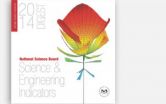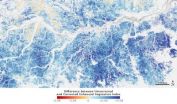(Press-News.org) The United States' (U.S.) predominance in science and technology (S&T) eroded further during the last decade, as several Asian nations--particularly China and South Korea--rapidly increased their innovation capacities. According to a report released today by the National Science Board (NSB), the policy making body of the National Science Foundation (NSF) and an advisor to the President and Congress, the major Asian economies, taken together, now perform a larger share of global R&D than the U.S., and China performs nearly as much of the world's high-tech manufacturing as the U.S.
Evidence in NSB's biennial report, Science and Engineering Indicators, which provides the most comprehensive federal information and analysis on the nation's position in S&T, makes it increasingly clear that the U.S., Japan, and Europe no longer monopolize the global R&D arena. Since 2001, the share of the world's R&D performed in the U.S. and Europe has decreased, respectively, from 37 percent to 30 percent and from 26 percent to 22 percent. In this same time period, the share of worldwide R&D performed by Asian countries grew from 25 percent to 34 percent. China led the Asian expansion, with its global share growing from just 4 percent to 15 percent during this period.
"The first decade of the 21st century continues a dramatic shift in the global scientific landscape," said NSB Chairman Dan Arvizu, who is also the director and chief executive of the National Renewable Energy Laboratory. "Emerging economies understand the role science and innovation play in the global marketplace and in economic competitiveness and have increasingly placed a priority on building their capacity in science and technology."
Recognition on the part of national leaders that S&T innovation contributes to national competitiveness, improves living standards, and furthers social welfare has driven the rapid growth in R&D in many countries. China and South Korea have catalyzed their domestic R&D by making significant investments in the S&T research enterprise and enhancing S&T training at universities. China tripled its number of researchers between 1995 and 2008, whereas South Korea doubled its number between 1995 and 2006. And there are indications that students from these nations may be finding more opportunities for advanced education in science and employment in their home countries.
In addition to investing in their research and teaching enterprises, these countries have focused their attention on crucial sectors of the global economy, including high-tech manufacturing and clean energy. The size of China's high-tech manufacturing industry increased nearly six-fold between 2003 and 2012, raising China's global share of high-tech manufacturing from eight percent to 24 percent during that decade, closing in on the U.S. share of 27 percent. In addition, emerging economies now invest more in clean energy--a critical 21st century industry--than advanced economies. In 2012, emerging economies invested nearly $100 billion in clean energy, primarily wind and solar, with China serving as the "primary driver of investment" with $61 billion. China's investment is more than double the $29 billion spent in the U.S.
Parent companies of U.S. multinational corporations (MNCs) perform over 80 percent of their worldwide R&D in the U.S. However, U.S. MNCs continue to increase their R&D investments in countries such as Brazil, China, and India, both reflecting and further contributing to a more globally-distributed R&D landscape. Majority-owned foreign affiliates of U.S. MNCs, for example, tripled their R&D investments in India and more than doubled them in Brazil between 2007 and 2010, nearly reaching the expenditure levels of the U.S. affiliates in China.
U.S. R&D rebounds from Great Recession
The 2008-09 recession took a toll on U.S. R&D. U.S. R&D expenditures declined in 2009, primarily due to a sharp drop in business R&D, which comprises the largest portion of U.S. R&D. This decrease in business R&D was partially offset by a temporary increase in Federal R&D funding through the 2009 American Recovery and Reinvestment Act.
However, comprehensive data covering the post-economic downturn period reveal that the U.S. has rebounded from the Great Recession better than other developed countries. By 2011, with a resurgence of business R&D, overall R&D funding had returned to 2008 levels, when adjusted for inflation. Indicators data also show that S&T degree and job holders weathered the recession better than others in the U.S. workforce.
(The report released today does not cover the period during which Federal R&D was cut sharply by sequestration. The National Science Foundation reports that Federal R&D funding has declined in each fiscal year since 2010, dropping by 7.1 percent in fiscal year 2013.)
U.S. high-tech industries have generally fared better than those of other developed economies in the aftermath of the recession. In contrast to the European Union (E.U.) and Japan, the value-added output of U.S. high-tech industries grew in 2010-12, surpassing pre-recession levels. Similarly, commercial investment in clean energy technology declined sharply in the E.U. during the recession and has yet to return to pre-downturn levels.
One of the most notable S&T trends of the last decade has been the increased innovation capacity of emerging economies as they narrowed many gaps with the West. However, the U.S. S&T enterprise remains the global leader. For example, the U.S. invests twice as much as any other single nation in R&D, despite slipping to tenth in world ranking of the percentage of its GDP it devotes to R&D. In 2011, the U.S. spent $429 billion on R&D, compared to China's $208 billion and Japan's $146 billion. Among other S&T metrics, the U.S. leads in high quality research publications, patents, and income from intellectual property exports.
"The United States remains the world's leader in science and technology," said Ray Bowen, NSB member and chairman of its Committee on Science and Engineering Indicators, which oversees development of the report. "But there are numerous indicators showing how rapidly the world is changing and how other nations are challenging our predominance. As other countries focus on increasing their innovation capacities, we can ill afford to stand still. We now face a competitive environment undreamed of just a generation ago," said Bowen, visiting distinguished professor, Rice University and president emeritus of Texas A&M University.
INFORMATION:
The 2014 volume of Science and Engineering Indicators is prepared by NSF's National Center for Science and Engineering Statistics (NCSES) on behalf of NSB. Indicators provides quantitative information on science, mathematics, and engineering education at all levels, the scientific and engineering workforce, domestic and international R&D performance, U.S. competitiveness in high technology, and public attitudes and understanding of science and engineering. The publication is subject to extensive review by outside experts, other Federal agencies, NSB members, and NCSES internal reviewers. It is available at: http://www.nsf.gov/statistics/indicators/.
-NSF-
US lead in science and technology shrinking
Emerging economies shifting global S&T landscape
2014-02-06
ELSE PRESS RELEASES FROM THIS DATE:
Prickly protein
2014-02-06
A genetic mechanism that controls the production of a large spike-like protein on the surface of Staphylococcus aureus (staph) bacteria alters the ability of the bacteria to form clumps and to cause disease, according to a new University of Iowa study.
The new study is the first to link this genetic mechanism to the production of the giant surface protein and to clumping behavior in bacteria. It is also the first time that clumping behavior has been associated with endocarditis, a serious infection of heart valves that kills 20,000 Americans each year. The findings were ...
NASA study points to infrared-herring in apparent Amazon green-up
2014-02-06
For the past eight years, scientists have been working to make sense of why some satellite data seemed to show the Amazon rain forest "greening-up" during the region's dry season each year from June to October. The green-up indicated productive, thriving vegetation in spite of limited rainfall.
Now, a new NASA study published today in the journal Nature shows that the appearance of canopy greening is not caused by a biophysical change in Amazon forests, but instead by a combination of shadowing within the canopy and the way that satellite sensors observe the Amazon during ...
Valentine's Day advice: Don't let rocky past relations with parents spoil your romance
2014-02-06
University of Alberta relationship researcher Matt Johnson has some Valentine's Day advice for anybody who's had rocky relations with their parents while growing up: don't ...
Falcon feathers pop-up during dive
2014-02-06
Similar to wings and fins with self-adaptive flaps, the feathers on a diving peregrine falcon's feathers may pop-up during high speed dives, according to a study published in PLOS ONE on February 5, 2014 by Benjamin Ponitz from the Institute of Mechanics ...
New, high-tech prosthetics and orthotics offer active life-style for users
2014-02-06
TAMPA, Fla. (Feb. 5, 2014) – Thanks to advanced technologies, those who wear prosthetic and orthotic devices ...
University of Montana research shows converting land to agriculture reduces carbon uptake
2014-02-06
MISSOULA – University of Montana researchers examined the impact that converting natural land to cropland has on global vegetation growth, as measured by satellite-derived ...
Bacterial fibers critical to human and avian infection
2014-02-06
Escherichia coli—a friendly and ubiquitous bacterial resident in the guts of humans and other animals—may occasionally colonize regions outside the intestines. There, it can have serious consequences for health, ...
Study suggests whole diet approach to lower CV risk has more evidence than low-fat diets
2014-02-06
Philadelphia, PA, February 5, 2014 – A study published in The American Journal of Medicine ...
Bundles of nerves and arteries provide wealth of new stem cell information
2014-02-06
A new Ostrow School of Dentistry of ...
Birds of a different color
2014-02-06
SALT LAKE CITY, Feb. 6, 2014 – Scientists at the University of Utah identified mutations in three key genes that determine feather color in domestic rock pigeons. The same genes control pigmentation ...
LAST 30 PRESS RELEASES:
University of Oklahoma researcher awarded funding to pursue AI-powered material design
Exploring how the visual system recovers following injury
Support for parents with infants at pediatric check-ups leads to better reading and math skills in elementary school
Kids’ behavioral health is a growing share of family health costs
Day & night: Cancer disrupts the brain’s natural rhythm
COVID-19 vaccination significantly reduces risk to pregnant women and baby
The role of vaccination in maternal and perinatal outcomes associated with COVID-19 in pregnancy
Mayo Clinic smartwatch system helps parents shorten and defuse children's severe tantrums early
Behavioral health spending spikes to 40% of all children’s health expenditures, nearly doubling in a decade
Digital cognitive behavioral treatment for generalized anxiety disorder
Expenditures for pediatric behavioral health care over time and estimated family financial burden
Air conditioning in nursing homes and mortality during extreme heat
The Alps to lose a record number of glaciers in the next decade
What makes a good proton conductor?
New science reporting guide published for journalists in Bulgaria
New international study reveals major survival gaps among children with cancer
New science reporting guide published for journalists in Turkey
Scientists develop a smarter mRNA therapy that knows which cells to target
Neuroanatomy-informed brain–machine hybrid intelligence for robust acoustic target detection
Eight SwRI hydrogen projects funded by ENERGYWERX
The Lundquist Institute and its start-up company Vitalex Biosciences Announces Strategic Advancement of Second-Generation fungal Vaccine VXV-01 through Phase 1 Trials under $40 Million Competitive Con
Fine particles in pollution are associated with early signs of autoimmune disease
Review article | Towards a Global Ground-Based Earth Observatory (GGBEO): Leveraging existing systems and networks
Penn and UMich create world’s smallest programmable, autonomous robots
Cleveland researchers launch first major study to address ‘hidden performance killer’ in athletes
To connect across politics, try saying what you oppose
Modulating key interaction prevents virus from entering cells
Project explores barriers to NHS career progression facing international medical graduates
Jeonbuk National University researchers explore the impact of different seasonings on the flavor perception of Doenjang soup
Two Keck Medicine of USC Hospitals named Leapfrog Top Teaching Hospitals
[Press-News.org] US lead in science and technology shrinkingEmerging economies shifting global S&T landscape


